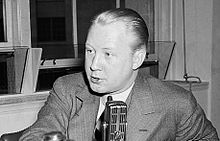Frank Stanton (executive)
| Frank Stanton | |
|---|---|

1939 photo
|
|
| Born |
Frank Nicholas Stanton March 20, 1908 Muskegon, Michigan |
| Died | December 24, 2006 (aged 98) Boston, Massachusetts |
| Occupation | President of CBS |
| Spouse(s) | Ruth Stephenson |
| Parent(s) | Josephine Schmidt Frank Cooper Stanton |
Frank Nicholas Stanton (March 20, 1908 – December 24, 2006) was an American broadcasting executive who served as the president of CBS between 1946 and 1971 and then as vice chairman until 1973. He also served as the chairman of the Rand Corporation from 1961 until 1967.
Stanton was born March 20, 1908 in Muskegon, Michigan to Helen Josephine Schmidt and Frank Cooper Stanton. He attended Stivers School for the Arts (then called Stivers High School) in Dayton, Ohio. He then attended Ohio Wesleyan University in Delaware, Ohio, receiving a B.A. in 1930. He married his childhood sweetheart, Ruth Stephenson, in 1931. He taught for one year in the manual arts department of a high school in Dayton, then attended Ohio State University, where he received his Ph.D. in 1935. He also held a diploma from the American Board of Professional Psychology. His doctoral thesis was entitled A Critique of Present Methods and a New Plan for Studying Radio Listening Behavior; for his research, he invented a device that would make a reliable, automatic record of radio listening. Soon after earning his Ph.D., Stanton became the third employee in the CBS research department. By 1942 he was a vice president of CBS and a fellow of the American Association of Applied Psychology, as well as a member of the American Psychological Association, the American Statistical Association, and the American Marketing Association; he was on the editorial board of the journal Sociometry. During World War II, he consulted for the Office of War Information, the Secretary of War, and the Department of the Navy, while serving as a vice president at CBS. He was selected as the administrator-designate of the Emergency Communications Agency, part of a secret group created by President Eisenhower in 1958 that would serve in the event of a national emergency that became known as the Eisenhower Ten.
...
Wikipedia
